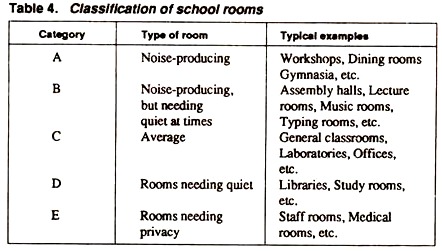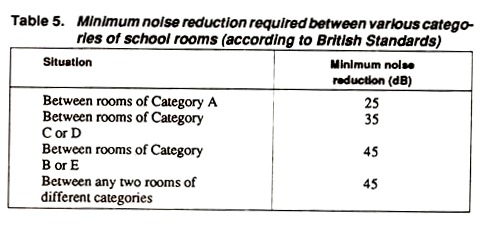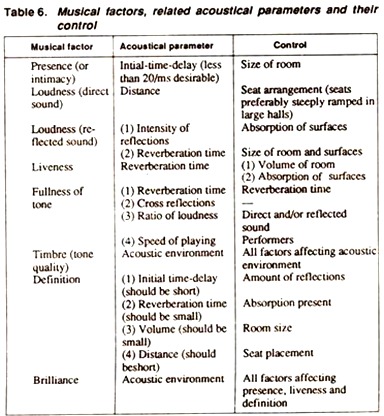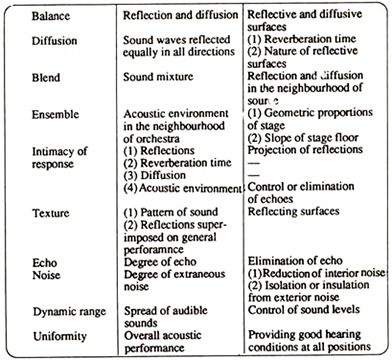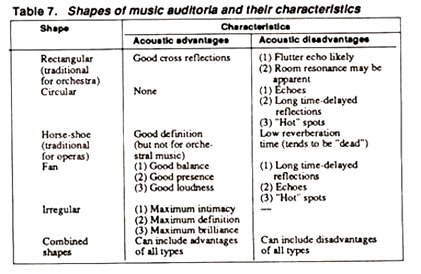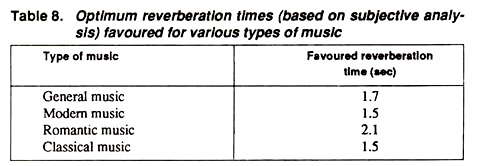This article throws light upon the six main types of auditorium. The types are: 1. Lecture Halls 2. Classrooms 3. Theatres 4. Auditoria for Music 5. Concert Halls and Opera Houses 6. Studios.
Type # 1. Lecture Halls:
There is a wide variation in the size of lecture halls. With respect to acoustic properties, larger lecture halls may be treated very’ much like theatres, posing the same acoustic design problems as listed in Table 3. If the acoustic design of a lecture hall is good, sound amplification systems may not be required until its size exceeds about 1,400 m3, or the hall accommodates an audience of more than 500.
In all cases, the reverberation time is probably best calculated on the basis of a 2/3 audience attendance (i.e., for average conditions which assume that the lecture hall will be two thirds full).
In the design of modern lecture halls, particular attention is paid to achieve the exclusion of external noise, and this implies the exclusion of natural light and ventilation. This can place a premium on the design of ceiling units carrying the necessary artificial lighting, and on achieving suitable suppression of noise in ventilation and air-conditioning systems.
Smaller lecture halls forming part of a budding (e.g., classrooms in schools and colleges) may demand special attention to exclude external noises generated in adjacent rooms, with particular consideration given to flanking transmissions of noise.
The acoustic treatment of halls intended for the delivery of both speech and music does not generally present any special problems until the volume of such dual purpose hall exceeds about 3,000 m3.
The reverberation time can be a compromise between the requirements for speech and music (e.g., a reverberation time between 1 and 2 seconds) and still give acceptable listening, with either speech or music, in the case of smaller halls.
If the dual-purpose hall is used mainly for speech, the lower reverberation time (nearer to 1 second) would be best. If musical performance, on the other hand, is the main use to which a hall a put, a reverberation time approaching or even slightly exceeding 2 seconds (depending on the type of music to be performed) is desirable.
One should keep in mind, however, that a compromise reverberation time is not likely to produce entirely satisfactory results with either speech or music.
Type # 2. Classrooms:
No severe acoustical design problems are presented by classrooms, except those regarding the necessary sound insulation. This can be analysed in terms of occupancy and adjacency. The classification of school rooms according to their occupancy is shown in Table 4.
The concept of “adjacency” is concerned with the minimum noise reduction between rooms of various categories listed in Table 4. The minimum reduction of noise required between school rooms of various categories (given in Table 4), recommended according to British Standards, is given in Table 5.
When a room has a dual use, it is to be classified according to the more severe requirement. For example, a Category C room, also used at times for Category B duties, would be considered as a Category B room.
In schools and colleges, the volumes of classrooms usually lie between 225 and 350 m3, with corresponding floor areas ranging from about 50 to 100 m2. For classrooms of such dimensions, acoustic treatment is seldom necessary to achieve optimum reverberation times of 0.6 to 0.9 seconds, when full.
Type # 3. Theatres:
Theatres require high intelligibility of speech, good volume of sound, and speech quality sufficient for the audience to appreciate the dramatic or subtle effects being put over by the actors.
Due to all these requirements, theatres present the greatest problems in acoustic design. These problems, moreover, are further aggravated by the large volumes which may be required to accommodate large audiences, and the relationship between the performing area and the audience area.
The problems encountered in acoustic design of theatres are as follows:
(a) Providing ample and powerful short-delayed reflections to every part of the audience area;
(b) Securing even distribution of sound throughout the theatre;
(c) Raising the source of sound and raking the audience area;
(d) Providing short-delayed back reflections onto the performing areas;
(e) Obtaining ideal reverberation time vs. frequency characteristics for performances other than stage plays;
(f) Eliminating echoes, long-delayed reflections and sound concentrations from the frequently-used circular form of theatres without creating an overly-dead acoustical environment;
(g) Locating the seats in the theatre so that sufficient sound waves (especially the high-frequency components of speech) reach the spectators sitting behind the performer;
(h) Accommodating a sufficiency large and easily demountable shell on the acting area, with variable capacity; and
(i) Installing an unobtrusive, high-quality sound amplification system when the audience capacity exceeds about 1,500.
Type # 4. Auditoria for Music:
The quality of music is usually rated subjectively rather than objectively, and no amount of mechanical analysis will produce a correlation between the objective measurements and subjective response. Mechanical analysis may indicate (in mechanical terms) the mathematical form of even the most complex sounds; but it cannot express precisely and completely the individual appreciation of the sounds involved.
The “quality” of music is affected by a very large number of factors; and so many of these are influenced by the acoustic environment that often the environment itself can be as important as the musical composition, or its performance.
Musical style and acoustics are so clearly related that the composition, as well as the design of an auditorium can be affected. This means in practice that there is an optimum acoustical environment for a particular musical composition and rendering. Similarly, there is an optimum composition for a particular acoustic environment. Auditorium design, therefore, may have to compromise to cover various types of performances.
Musical factors (those affecting the subjective response to music) and the related acoustical parameters are summarised in Table 6. The information in this table, however, can only serve as a very general guide for the requirements of acoustical design of auditoria.
This table does not include non-acoustical factors (e.g., aesthetic, environmental, structural, financial and other requirements) which may also be involved in an individual’s appreciation of music. Basic shapes of auditoria, together with some of their main acoustic characteristics, are summarised in Table 7.
One of the most important (and traditional) parameters in auditoria design is the reverberation time. This, however, has to be a compromise, the auditorium is designed for a specific type of musical performance only.
The optimum reverberation time for music is largely independent of volume of the auditorium (in contrast to that for speech); but it is related to the type of music. Optimum reverberation times, based on subjective analysis, favoured for various types of music are shown in Table 8.
Of course, reverberation time is an objective parameter which can be readily determined. Although measured reverberation times in auditoria often differ appreciably from design estimates, such differences can be eliminated or adjusted, as required, by further acoustic treatment.
Control of reverberation times will directly affect the quality of music. Various factor affecting the quality of music in an auditorium and their corresponding requirements are shown in Table 9. For good quality music, there must also be an absence (or minimum presence) of acoustical defects. These are shown in Table 10.
Diffusion of sound can be controlled by surface treatment. Projections and irregularities of surface provide diffusion of sound and an equal balance of sound pressure levels.
Surface irregularities and projections, though, must be quite large (about one-seventh of a wavelength) to be effective. Alternative treatment (to provide diffusion of sound) includes the random or alternate application of absorptive and reflective treatments, and the elimination of any degree of parallelism.
Type # 5. Concert Halls and Opera Houses:
The requirements for concert halls and opera houses differ appreciably from those for other types of auditoria. Lower reverberation times are required, in general, to improve the intimacy and definition of sound in concert halls and opera houses.
Moreover, the optimum reverberation time, and the shape of the theatre, will depend on the type of opera being performed. For example, the operas requiring more fullness of tone generally benefit from higher reverberation times.
A further difference is found in the size of the auditoria rendered in terms of recommended volume per seat, as shown in Table 11. By comparison, the optimum volume per seat for the auditoria used for speech is 2-8 m3.
Type # 6. Studios:
Studios used for microphone pick-up have their own special requirements.
They demand particular attention to:
(a) Optimum size;
(b) Optimum shape;
(c) Optimum reverberation characteristics;
(d) High degree of difference; and
(e) Low level of background noise.
A good guide to optimum sizes for studios is given by the BBC (British Broadcasting Corporation) minimum volume requirements for music studios, as shown in Table 12.
It should be noted, though, that the minimum studio volume is not directly proportional to the number of performers. The minimum volume per performer for four performers, for example, is 10.6 m3, which rises to 48.2 m3 per performer when 128 performers are present.
The volume requirements of studios may also be expressed as simple ratios of the height of the room to its width and length, as shown in Table 13. If the studio necessarily has a low ceiling, then the width and length ratios should be modified to 2.50 and 3.20, respectively.
On the other hand; if the studio necessarily has excessive length relative to its width, then the desirable ratios are 1.25 and 3.20 for the width and length, respectively.
Optimum reverberation characteristics of a studio are modified by the distance between the source of sound and microphone, and also the acoustic characteristics of the room. The latter may, however, be adjusted as necessary by variable absorption and screening treatments.
